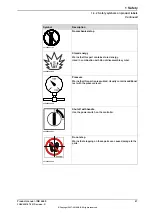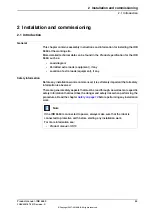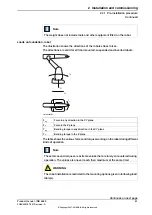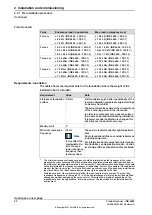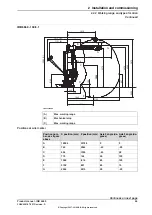
Floor mounted
Max. load (emergency stop)
Endurance load (in operation)
Force
± 12.8 kN (IRB 6660 - 100/3.3)
± 7.6 kN (IRB 6660 - 100/3.3)
Force xy
± 16.1 kN (IRB 6660 - 130/3.1)
± 8.5 kN (IRB 6660 - 130/3.1)
± 14.9 kN (IRB 6660 - 205/1.9)
± 7.9 kN (IRB 6660 - 205/1.9)
18.5 ± 7.4 kN (IRB 6660 - 100/3.3)
18.5 ± 3.7 kN (IRB 6660 - 100/3.3)
Force z
18.8 ±12.8 kN (IRB 6660 - 130/3.1)
18.8 ± 8.4 kN (IRB 6660 - 130/3.1)
18.0 ±7.7 kN (IRB 6660 - 205/1.9)
18.0 ± 4.4 kN (IRB 6660 - 205/1.9)
± 33.4 kNm (IRB 6660 - 100/3.3)
± 24.4 kNm (IRB 6660 - 100/3.3)
Torque xy
± 37.2 kNm (IRB 6660 - 130/3.1)
± 25.6 kNm (IRB 6660 - 130/3.1)
± 32.4 kNm (IRB 6660 - 205/1.9)
± 19.6 kNm (IRB 6660 - 205/1.9)
± 14.5 kNm (IRB 6660 - 100/3.3)
± 7.6 kNm (IRB 6660 - 100/3.3)
Torque z
± 19.3 kNm (IRB 6660 - 130/3.1)
± 10.3 kNm (IRB 6660 - 130/3.1)
± 14.7 kNm (IRB 6660 - 205/1.9)
± 7.1 kNm (IRB 6660 - 205/1.9)
Requirements, foundation
The table shows the requirements for the foundation where the weight of the
installed robot is included:
Note
Value
Requirement
Flat foundations give better repeatability of the
resolver calibration compared to original settings
on delivery from ABB.
0.3 mm
Flatness of foundation
surface
The value for levelness aims at the circumstance
of the anchoring points in the robot base.
In order to compensate for an uneven surface,
the robot can be recalibrated during installation.
If resolver/encoder calibration is changed this
will influence the absolute accuracy.
5°
Maximum tilt
The value is recommended for optimal perform-
ance.
22 Hz
Note
It may affect the
manipulator life-
time to have a
lower resonance
frequency than
recommended.
Minimum resonance
frequency
Due to foundation stiffness, consider robot mass
including equipment.
i
For information about compensating for founda-
tion flexibility, see
Application manual - Control-
ler software IRC5
, section
Motion Process Mode
.
i
The minimum resonance frequency given should be interpreted as the frequency of the robot
mass/inertia, robot assumed stiff, when a foundation translational/torsional elasticity is added, i.e.,
the stiffness of the pedestal where the robot is mounted. The minimum resonance frequency should
not be interpreted as the resonance frequency of the building, floor etc. For example, if the equivalent
mass of the floor is very high, it will not affect robot movement, even if the frequency is well below
the stated 25 Hz. The robot should be mounted as rigid as possibly to the floor.
Disturbances from other machinery will affect the robot and the tool accuracy. The robot has
resonance frequencies in the region 10 – 20 Hz and disturbances in this region will be amplified,
although somewhat damped by the servo control. This might be a problem, depending on the
requirements from the applications. If this is a problem, the robot needs to be isolated from the
environment.
Continues on next page
52
Product manual - IRB 6660
3HAC028197-001 Revision: S
© Copyright 2007-2018 ABB. All rights reserved.
2 Installation and commissioning
2.2.1 Pre-installation procedure
Continued
Содержание IRB 6660
Страница 1: ...ROBOTICS Product manual IRB 6660 ...
Страница 2: ...Trace back information Workspace R18 2 version a18 Checked in 2018 11 20 Skribenta version 5 3 012 ...
Страница 8: ...This page is intentionally left blank ...
Страница 18: ...This page is intentionally left blank ...
Страница 48: ...This page is intentionally left blank ...
Страница 108: ...This page is intentionally left blank ...
Страница 172: ...This page is intentionally left blank ...
Страница 366: ...This page is intentionally left blank ...
Страница 386: ...This page is intentionally left blank ...
Страница 388: ...This page is intentionally left blank ...
Страница 394: ......
Страница 395: ......










